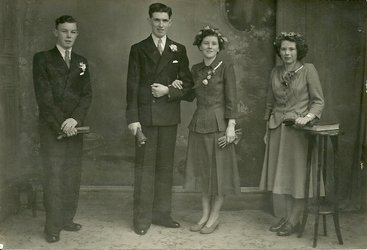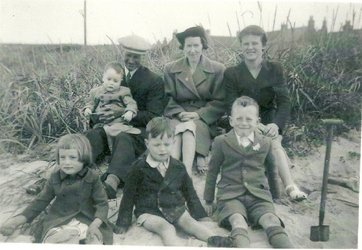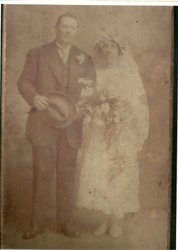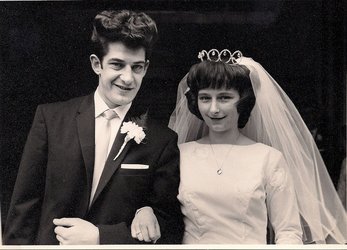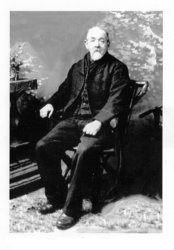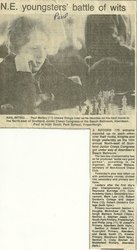This site was originally founded by Kenny Malley who sadly passed away on the 5th September 2012. This is a new subject to me but I will endevour to do my best to keep his website and research alive.
Fraserburgh locally known as "The Broch"
Fraserburgh, a town and a parish in the NE extremity of Aberdeenshire. Founded by Alexander Fraser of Philorth in 1569, at first the town was known as Faithlie, the name of a free burgh of barony erected by charter of Queen Mary five years earlier; but by a new charter of 1601, it was constituted 'a free port, free burgh of barony, and free regality, to be called in all time coming,
the Burgh and Regality of Fraserburgh.' It is built on the southern slope of Kinnaird's Head, and along the western shore of Fraserburgh Bay, by road being 22 miles E of Banff and 17½ NNW of Peterhead, whilst by rail, as terminus of the Formartine and Buchan branch (1865) of the Great North of Scotland railway, it is 13 miles NNE of Maud Junction, 41 NNE of Dyce Junction, 47½ N by E
of Aberdeen, 162¼ NNE of Edinburgh, and 200 NE by N of Glasgow. Kinnaird's Head The Frasers' castle here, dating from 1570, is a rectangular four-storied tower, 39 feet by 27; on its roof a lighthouse was built in 1787, whose lantern, rising 120 feet above high water mark, shows a fixed light, red over Rattray Briggs, white in all other directions, and visible at a distance of 17 nautical miles. A sea-crag, 50 yards to the eastward, is crowned by the massive ' Wine Tower,' which, measuring 25¼ by 20 feet, and 25 high on the landward side, contains two vaulted apartments. The only doorway is on the upper story, and the wooden stair leading up to this
is modern, so that how the tower was formerly entered, and what was its purpose, remain a puzzle to
the antiquary. The style, however, of five freestone carvings, that adorn the roof and two windows,
is thought to refer it to the 15th century. Beneath it is a cave, the Selches Hole, believed to penetrate 100 feet, but now much choked with stones. Scarce a vestige remains of a square three- storied tower at the W end of the town, part of a college begun by Alexander Fraser, he having obtained a charter in 1592 to erect a university. The scheme fell through, but his building was once called into requisition, when, on the outbreak of the plague at Aberdeen in 1647, King's College for a time removed to Fraserburgh. The town itself, overlooking the harbour and bay, is neat and regular. Its principal streets run parallel to the bay, with others crossing at right angles; and recent shoreward improvements and northward extensions have always tended to enhance its symmetry. The Town House, built in 1855, is a handsome Grecian edifice, whose dome-crowned tower contains a niche, with a statue of Alexander Fraser, sixteenth Lord Saltoun (1785-1853), a hero of Waterloo and of the Chinese opium war. His portrait hangs in the town-hall, on the second floor, with one of his ancestor, the founder of the town. A market-cross, erected by that founder, stood originally on a large hexagonal basement, with nine gradations of steps; and, as restored in 1853, is an oval stone shaft 12 feet in height, surmounting a pedestal, and itself surmounted by the Royal and Fraser arms. The prison since 1874 has served only for the detention of prisoners whose period does not exceed three days. The parish church, rebuilt in 1802 and restored in 1873- 74, is a plain structure, with clock-tower and spire and 1000 sittings. The new West quoad sacra church (1877; 800 sittings) cost £4000, and has a very effective spire. A fine new Free church was erected in 1880 at a cost of £6398; and other places of worship are the U.P. church (1875; 350 sittings), the Congregational church (1853; 550 sittings), the Evangelical Union church (1854), the
Baptist church (1880), and St Peter's Episcopal church (1791; 300 sittings). The last is a cruciform pseudo Norman edifice, enlarged and refitted in 1840 and 1880, with a good organ and a marble tablet to Bishop Alexander Jolly, D.D. (1755-1838), who from 1788 till his death was minister here, and a Life of whom, by the Rev. W. Walker (2d ed., Edinb., 1878), contains much of interest relating to Fraserburgh. The Academy, opened in 1872, was built at a cost of £2700, and further endowed with £5000, by the late James Park, merchant; the Girls' Industrial school (1863) was mainly founded by the late Miss Strachan of Cortes, as a memorial to her brother, James Strachan, Esq., M.D., Inspector General of Army Hospitals, Madras; and a new public school, costing
over £6000, was opened in Sept. 1882. It has accommodation for 800 children, and supersedes the former burgh school. The hospital was built by the late Thomas Walker, fishcurer, and gifted by him
to the town; whilst the Dalrymple public hall and cafe was built at a cost of £4500, upwards of £2300 of which was given by the late Captain John Dalrymple. It is Scottish Baronial in style, and the hall has accommodation for 1100 persons.
The harbour, founded by Alexander Fraser on 9 March 1576 in the name of Father, Son, and Holy Ghost, had only one small pier. The north, south, and middle piers were built between 1807 and 1837
at a cost of £30,000, the space within the pier heads being nearly 8 acres, with a depth, according
to the tides, of 11 to 16 feet of water inside and along the quays, and of 6 to 20 feet at the entrance. In 1855 and following years a new N harbour of 8 acres of sheltered water, with a low- water depth of 10 feet at the entrance, was formed by the construction of a pier and breakwater, giving a total berthage of 8850 feet, of which 6025 are available for shipping. The estimated cost of this N harbour (£25,000) was more than doubled, and even then the breakwater was left unfinished
till 1875, when, and in following years, it was carried to a length of 850 feet. The latest undertaking (1881) has been the deepening of both harbours and the widening of the quays, £30,000 having been borrowed for that purpose from the Public Works Loan Commissioners., Of late years,' to
quote from an article on 'Fraserburgh' in the Scotsman of 11 April 1882,' the chief increase in the
herring fishery has been from the Aberdeenshire ports, the principal of which are Aberdeen, Peterhead, and Fraserburgh. During the season of 1874, about the most productive year on record up till 1880, more than 1800 boats were fishing from these ports and their immediate neighbourhood, and about 400, 000 crans of fish, or more than one-third of the entire take of herrings in Scotland, were captured by these boats; so that the market value of the herrings now brought into the Aberdeenshire ports in an average year is equal to the whole land rental of the county. The sea
is thus as productive as the land; and if there were better harbour accommodation-though that of late years has been considerably improved-the production of the sea might be still further increased. The requisites of a perfect fishing-boat harbour are an entrance that will allow the largest class of boats to have free access and egress at all times of the tide; perfect shelter within the entrance; sufficient space for all the boats that frequent the place during the fishing season to lie together without crowding or jostling; enough depth of water inside to enable them to
be afloat at all times of the tide; and proper facilities for fitting out, taking in their nets, lines, and other gear, and for landing their fish. Aberdeen, Peterhead, and Fraserburgh are the only ports on the stormy E coast of Scotland that possess to a considerable extent these requisites, and they have, consequently, reaped, and will continue to reap, a rich reward. Their proximity to the best fishing grounds of the teeming North Sea certainly gives them exceptional advantages; but without the sums judiciously expended at all the three places on harbour extension and improvement, these natural advantages would have been comparatively useless.
Origin of the Surname Sutherland
The Vikings from Norway ruled, and settled, much of the Highlands and Islands of Scotland, especially in the north and west, reaching their zenith around the 11th century. Norsemen called the most southerly area of their dominions Sudrland. This regional name was adopted by the inhabitants, thus creating the surname Sutherland. The area of Sutherland was originally the southern portion of the ancient Earldom of Caithness. In 1197 Sutherland became detached from the Norsemen when King William the Lion gave these lands to Hugh of Moray.
Hugh of Moray was a grandson of Freskin, the mutual ancestor of the Clan Chiefs of the Sutherlands and the Murrays. From these roots sprang the Clan Sutherland. Although there were frequent feuds with their neighbours, particularly the Mackays, the Sutherland Clan came to wield great power in the North of Scotland.
The Earldom of Sutherland is one of the oldest, continuous earldoms in Britain. Hugh’s son, William, became the first Earl around 1235. The third Earl fought for Robert the Bruce at Bannockburn (1314) and his brother, Kenneth, the fourth Earl, fell fighting the English at Halidon Hill (1333). The fifth Earl’s first wife was a daughter of Robert the Bruce, and their son might well have become heir to the throne, avoiding the Stewart dynasty, had he not died at an early age.
On the death of the ninth Earl, possession of the title was taken by the Gordons through marriage. Subsequent Earls retained the name Gordon until the end of the 17th century when the 16th Earl died, succession falling to his infant daughter, Elizabeth Gordon. She later married the Marquis of
Stafford, who was created the first Duke of Sutherland in 1833. They are infamous for their enthusiasm, shared by many contemporaries, for agricultural “improvements,” which involved some of the most brutal evictions of their tenant farmers in Scotland. These forced displacements during the 18th and 19th centuries became known as the Highland Clearances.
The motto of the Clan Sutherland is Sans Peur (Without Fear) and the Gaelic name is Sutherlarach. One of the results of the Highland Clearances was emigration, mainly to North America, and there are now more descendants of Sutherlands around the world than in Scotland itself.
Clan Sutherland tartan & motto, Sans Peur (Without Fear). A romantic interest in tartans was brought about by the writings of Sir Walter Scott in the 19th century; the idea of a tartan associated with a certain clan is a modern one.


